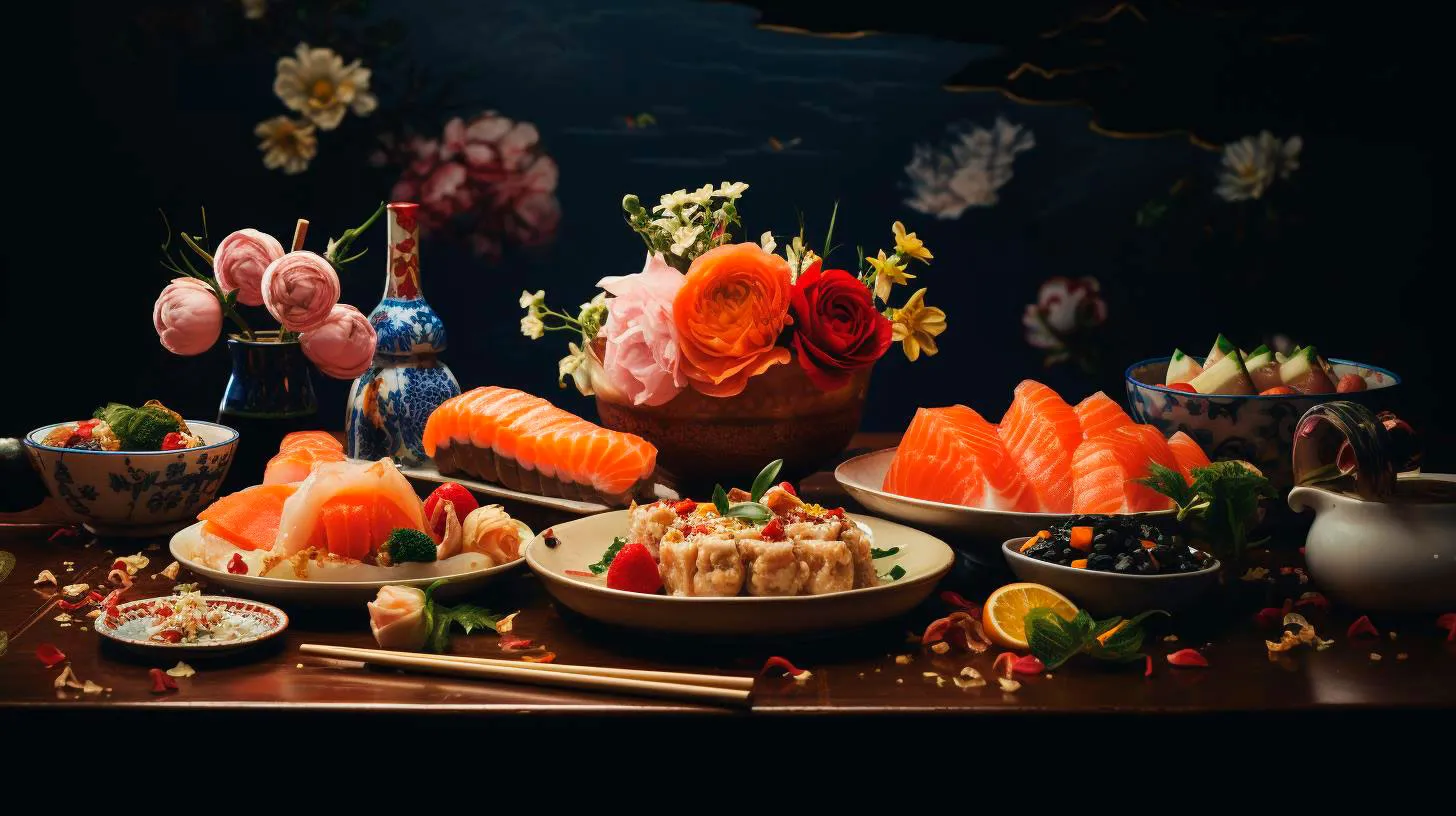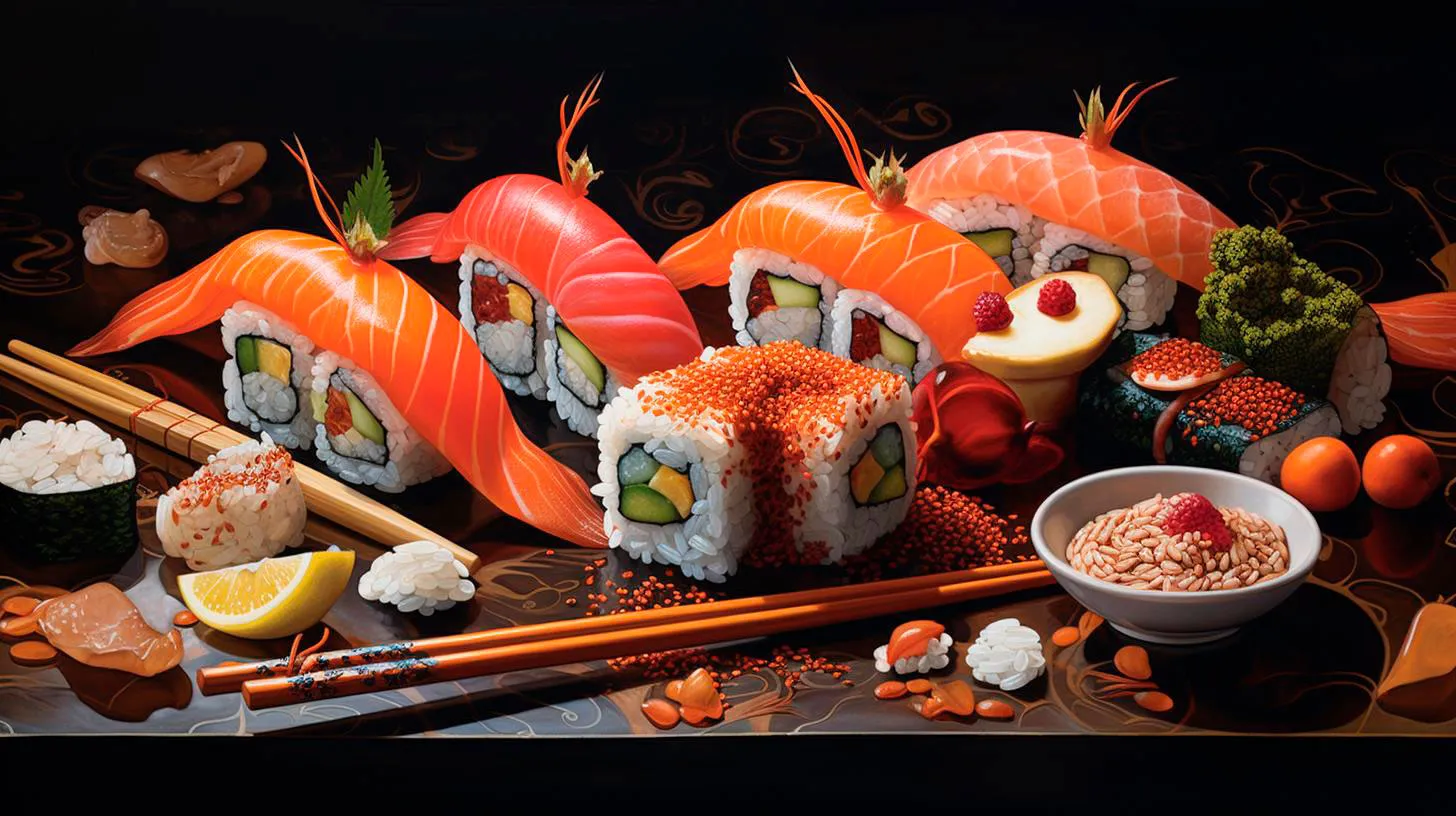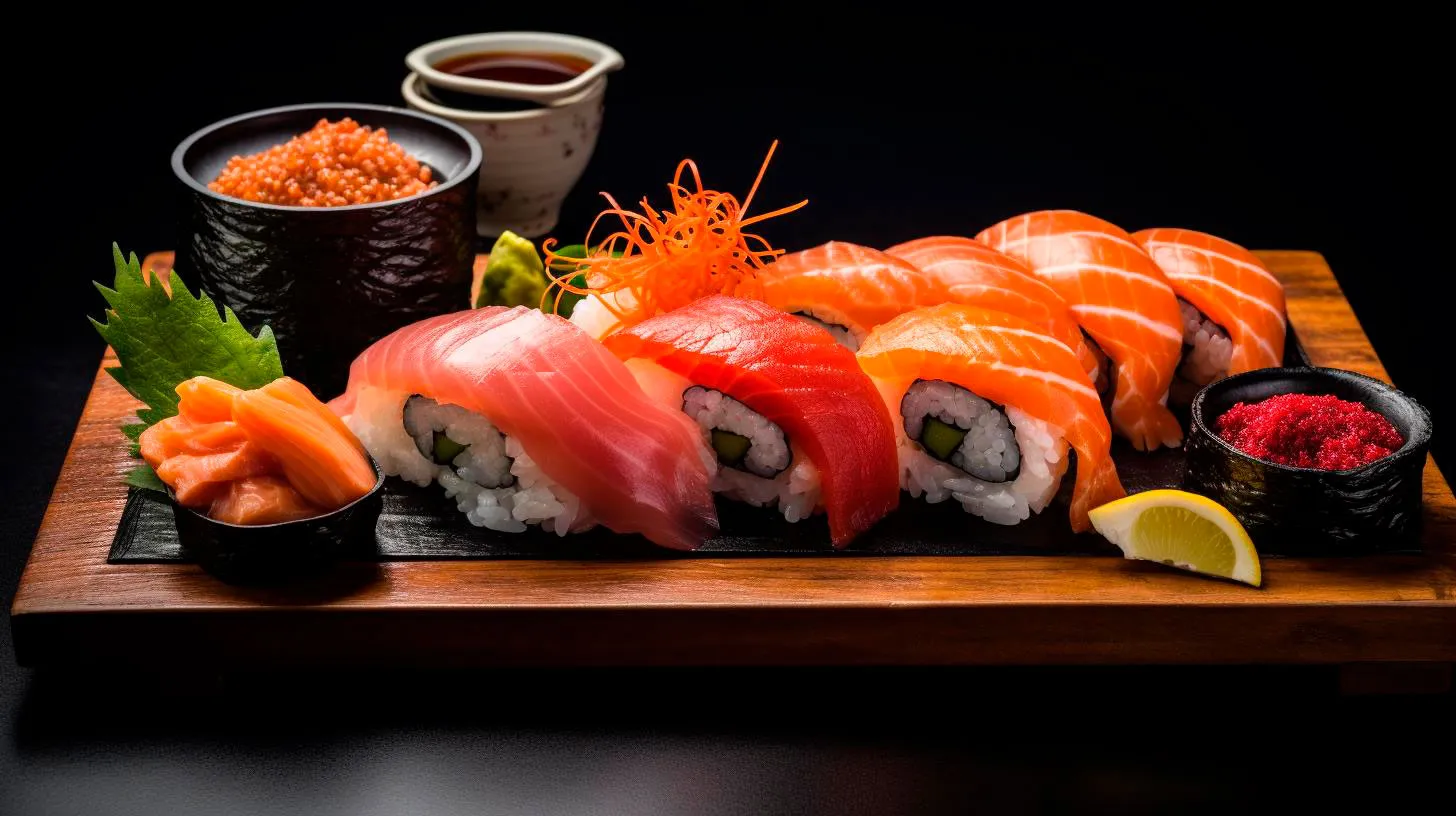The Art of Sushi: Exploring Its Intricate Cultural Significance
In this article, we dive into the cultural significance of sushi and explore the artistry behind this beloved dish.
The Origins of Sushi
The origins of sushi can be traced back to ancient times in Southeast Asia. It initially served as a means of preserving fish by fermenting it with rice. This preservation method allowed fish to be stored for several months, ensuring a constant food supply during long journeys and challenging climates.
Over time, the technique evolved, and sushi became a delicacy enjoyed by the Japanese aristocracy. During the Edo period (1603-1868), sushi transformed from a fermented dish to a more contemporary style. It was during this era that nigiri sushi, the familiar bite-sized pieces of fish on top of seasoned rice, gained popularity.
The Artistry of Sushi Making
Sushi making is a fine art that requires skill, precision, and an understanding of the ingredients. A master sushi chef, or Itamae, dedicates years perfecting their craft. Here are some key elements that contribute to the artistry of sushi making:
- Freshness: Sushi relies on the highest quality ingredients, particularly the fish. The fish chosen should be fresh, exhibiting a vibrant color and firm texture. To ensure the utmost freshness, some sushi restaurants even have their dedicated fish markets.
- Knife Skills: The precise cuts made by the chef can greatly influence the taste and texture of the sushi. Different cutting techniques, such as crosswise or diagonal, create variations in flavor and mouthfeel.
- Balance: Sushi is all about balance. The combination of flavors, textures, and colors should harmonize to create a well-rounded and satisfying experience in every bite.
- Presentation: Sushi is not just about taste; it is also a feast for the eyes. Every aspect of presentation is carefully considered, from the arrangement of the sushi on the plate to the artistic garnishes that accompany it.
The attention to detail and the pursuit of perfection make sushi not only a culinary experience but also an artistic one.
Sushi as a Cultural Symbol
Sushi holds deep cultural significance in Japan, symbolizing not only the country’s culinary tradition but also its values and way of life. Here are some notable cultural aspects associated with sushi:
- Harmony with Nature: Sushi epitomizes the Japanese respect for nature. The use of seasonal ingredients and an emphasis on simplicity highlight Japan’s seasonal rhythm and appreciation for the natural world.
- Attention to Detail: The meticulous preparation and presentation of sushi reflect the Japanese principle of “omotenashi” or wholehearted hospitality. Every aspect of the dining experience is carefully curated to ensure the utmost satisfaction of the guests.
- Discipline and Tradition: Sushi-making embodies the Japanese dedication to discipline and respect for tradition. Sushi chefs undergo years of training to master their craft, learning from their predecessors and upholding centuries-old techniques.
- Social Bonding: In Japanese culture, sushi often serves as a means of socializing and strengthening relationships. The communal dining style, where everyone shares from a central platter, fosters a sense of togetherness.
These cultural elements make sushi more than just a meal; it is a representation of Japan’s rich heritage and values.
The Global Influence of Sushi
Sushi’s popularity has transcended borders, making it a global culinary phenomenon. With sushi restaurants found in almost every major city, the art of sushi has become cherished worldwide. Here are some key takeaways regarding sushi’s global influence:
- Health Benefits: Sushi’s emphasis on fresh ingredients, particularly omega-3-rich fish, has contributed to its reputation as a healthy dining option. It is low in calories, high in nutrients, and offers numerous health benefits.
- Cross-Cultural Adaptation: Sushi has adapted to suit different palates and dietary preferences across the globe. From vegetarian rolls to creative fusion creations, sushi has evolved to cater to a diverse range of tastes and preferences.
- Tourism and Cultural Exchange: Sushi has become a draw for tourists visiting Japan, providing an avenue for cultural exchange. Visitors often seek out authentic sushi experiences, leading to increased appreciation and understanding of Japanese culture.
- Entrepreneurial Opportunities: The global popularity of sushi has also created entrepreneurial opportunities. Sushi chefs and enthusiasts have opened sushi restaurants, sushi-making classes, and even sushi-themed merchandise stores, further fueling the sushi craze.
As sushi continues to captivate palates worldwide, it serves as a testament to the enduring allure of Japanese culture and the artistry behind this iconic cuisine.
So, the next time you indulge in a piece of sushi, take a moment to appreciate the centuries-old tradition, the precision of its preparation, and the cultural significance it represents.
Sushi: A Culinary Masterpiece Preserving Centuries of Tradition
A Bite-sized History
Sushi, originating from Japan, has a history rooted in tradition and craftsmanship. It dates all the way back to the fourth-century when the food was first introduced in the Southeast Asian region. Originally, sushi was a means of preserving raw fish by fermenting it with rice. Over the years, this preservation technique evolved, and the sushi we know today emerged in the Edo period (1603-1868).
Initially, sushi was street food consumed with hands due to its convenient bite-size portions. It later transformed into an art form, attracting attention from both the common people and the aristocrats. Today, sushi is celebrated worldwide for its elegance, freshness, and delicate flavors that harmoniously blend together.
The Essentials of Sushi Making
Achieving sushi perfection requires not only fine ingredients but also the skills of a true sushi chef. Here are the fundamental elements and techniques that make sushi a culinary masterpiece:
- Top-Quality Ingredients: Sushi demands the freshest and highest-quality fish, such as tuna, salmon, and yellowtail. Rice, vinegar, seaweed, and condiments like soy sauce and wasabi are also vital components.
- Sushi Rice: The foundation of sushi lies in its rice. The grains are meticulously cooked, seasoned with vinegar, sugar, and salt, to create the perfect sticky consistency that holds the sushi together.
- Nigiri: A classic sushi style, nigiri showcases a slice of raw fish or seafood placed atop a small mound of rice. This technique requires precision in shaping the rice and a keen eye for selecting the ideal fish slices.
- Maki Rolls: Maki rolls are made by rolling sushi rice and various ingredients like fish, vegetables, or tempura in a sheet of dried seaweed called nori. They are then sliced into bite-sized pieces.
- Sashimi: Although not technically sushi, sashimi is a popular companion to sushi. It consists of thin slices of raw fish or seafood served without rice. The emphasis is solely on the fish’s freshness and texture.
The Artistry and Advantages of Sushi
Sushi is not just a meal; it’s an experience. Beyond its visual appeal, the artistry involved in crafting sushi makes it truly unique. Here are some advantages and key takeaways of embracing the sushi culture:
- Health Benefits: Sushi, particularly nigiri and sashimi, is rich in omega-3 fatty acids, high-quality proteins, and essential minerals. It can contribute to a heart-healthy diet and provide numerous health benefits.
- Cultural Exploration: Each sushi piece represents a blend of flavors and cultural heritage. Exploring various sushi styles and ingredients allows us to embark on a culinary journey through Japan’s different regions.
- Aesthetic Pleasures: Sushi’s elegant presentation and beautiful color combinations elevate the dining experience. Its visual appeal is often as captivating as its taste.
- Social Connection: Sushi is often enjoyed with friends or family, creating a shared experience of joy and bonding. The art of sushi encourages conversation and camaraderie around the dining table.
A Global Phenomenon
It’s no surprise that sushi has become a global phenomenon, adored by people from all walks of life. The rise in popularity can be attributed to several factors:
- Culinary Diversity: Sushi’s versatility allows it to adapt to different cultural cuisines, leading to unique fusion rolls and innovative creations that appeal to diverse palates.
- Healthy Eating Trend: With the increasing focus on healthy eating, sushi provides a nutritious and well-balanced option for those seeking a wholesome meal.
- Social Media Influence: Sushi’s photogenic nature has made it an Instagram sensation. The visual allure of sushi attracts food enthusiasts and drives its popularity through social media platforms.
- Tourism and Travel: Sushi has become synonymous with Japanese culture, attracting tourists who wish to immerse themselves in the country’s traditional cuisine.
In Conclusion
Sushi is not just a culinary masterpiece; it represents centuries of tradition and artistry. With its exquisite flavors and presentation, sushi has become a global sensation, beloved by people of all backgrounds. Whether you savor the delicate nigiri, indulge in the vibrant maki rolls, or explore the world of sashimi, sushi offers an unforgettable gastronomic experience.
So next time you take a bite of sushi, remember the centuries-old legacy behind it, and appreciate the harmonious blend of flavors that unite in this remarkable Japanese delicacy.
From Rice to Rococo: The Journey of Sushi from Ancient Origins to Modern Delicacy
In this article, we will delve into the ancient origins of sushi, its transformation over time, and how it has become a beloved delicacy in modern times.
The Ancient Roots of Sushi
The roots of sushi can be traced back to ancient China, where a similar dish called narezushi was developed. Narezushi consisted of fermented fish and rice, a process that enabled preservation in the absence of refrigeration. This technique made its way to Japan around the 8th century and quickly gained popularity. However, it wasn’t until the 17th century, during the Edo period, that sushi, as we know it today, truly started to take shape.
The Birth of Edomae Sushi
During the Edo period, Japan experienced a surge in urbanization and the growth of Edo (modern-day Tokyo) as a major city. With an abundance of fish from Tokyo Bay and the surrounding waters, sushi chefs began to experiment with various ingredients and techniques, creating what is known as Edomae sushi. This style of sushi emphasized the use of fresh fish caught from the nearby waters, resulting in a simple yet flavorful dish.
- Key Takeaway: Edomae sushi originated in Edo (Tokyo) during the Edo period and focused on using fresh fish caught from the nearby waters.
- Key Feature: The use of vinegared rice to complement the flavors of the fish.
The Modernization of Sushi
As Japan entered the Meiji era in the late 19th century, significant changes occurred in the country’s culinary landscape. Western influences led to the introduction of new ingredients and cooking techniques, which gradually transformed sushi into a more diverse and elaborate dish. Sushi restaurants also began to appear, making it accessible to a wider audience.
Sushi Goes Global
In the mid-20th century, sushi underwent a major transformation as it spread to other parts of the world. The introduction of refrigeration and the increasing popularity of Japanese cuisine played a significant role in this globalization. Sushi bars and Japanese restaurants started popping up in major cities worldwide, catering to a growing demand for this unique delicacy.
- Advantage: Sushi’s global popularity allows for a diverse range of ingredients, flavors, and presentation styles.
- Statistical Insight: As of 2020, the worldwide sushi market was valued at $16.2 billion.
The Art of Sushi: A Modern Delicacy
Today, sushi has transcended its humble origins to become a culinary art form. With its emphasis on fresh, high-quality ingredients and meticulous preparation, it has garnered a reputation as a refined and elegant dish. Sushi chefs, known as itamae, spend years perfecting their craft, ensuring that every aspect of the sushi-making process is executed with precision and care.
Traditional vs. Modern Sushi
The art of sushi has seen a fusion of traditional and modern techniques. While traditional sushi focuses on simplicity and purity of flavors, modern sushi chefs have experimented with new ingredients, presentation styles, and even fusion with other cuisines. This blend of tradition and innovation has given rise to unique sushi creations that delight both purists and adventurous eaters.
- Advantage: The fusion of traditional and modern techniques allows for endless creativity in sushi-making.
- Industry Statistic: The number of sushi restaurants in the United States alone has increased by 28% over the past decade.
The Evolution Continues
The journey of sushi, from its humble origins to its current status as a global delicacy, is a testament to its enduring appeal. As sushi continues to evolve, it is likely to incorporate new flavors, techniques, and cultural influences. Whether you prefer classic nigiri or inventive sushi rolls, this ancient culinary creation will continue to captivate our taste buds for generations to come.
So next time you savor a piece of sushi, take a moment to appreciate the thousands of years of history and craftsmanship that have culminated in the delectable dish before you.
Sushi: Celebrating Japan’s Rich Heritage Through a Mouthwatering Culinary Experience
The Art of Sushi Making
Crafting sushi is truly an art form that requires precision, skill, and a deep understanding of ingredients. The key element of sushi is rice, which is cooked to perfection using a specific combination of water, rice vinegar, and seasoning. The rice serves as the foundation on which various toppings, known as neta, are delicately placed.
- Key Takeaway: The art of sushi making is a testament to meticulousness and attention to detail.
Traditional sushi encompasses a variety of styles, including nigiri (hand-pressed sushi), maki (sushi rolls wrapped in seaweed), and sashimi (thinly sliced raw fish). Each style is distinct in its preparation, presentation, and flavor combinations, offering a diverse range of options to suit different palates.
The Health Benefits of Sushi
Apart from being a delicious treat, sushi is also known for its numerous health benefits. The core ingredients of sushi, namely fish and seaweed, provide essential nutrients and promote overall well-being. Fish is an excellent source of lean protein, omega-3 fatty acids, and vitamins, contributing to heart health and brain function.
- Key Takeaway: Sushi offers a tasty and nutritious way to incorporate fish into your diet.
Seaweed, a common ingredient in sushi, contains high levels of iodine, vitamins, and minerals. It supports thyroid function, boosts the immune system, and aids digestion. Additionally, sushi often includes vegetables like cucumber, avocado, and carrots, adding another layer of nutritional value to the meal.
The Cultural Significance of Sushi
Sushi reflects Japan’s unique culture and values. It is deeply rooted in traditions that emphasize simplicity, harmony, and respect for nature. The preparation and consumption of sushi showcase the Japanese commitment to quality, aesthetics, and mindfulness. It is not uncommon to see sushi chefs dedicating years to perfecting their craft and mastering the art of creating culinary masterpieces.
- Key Takeaway: Sushi provides an immersive experience into Japanese culture and philosophy.
Equally important is the role sushi plays in fostering social connections and communal dining experiences. Traditional sushi bars, known as sushi-ya, promote an intimate setting where customers can interact with the chef, ask questions, and learn more about the ingredients and techniques used. This communal aspect not only enhances the dining experience but also reinforces the importance of togetherness and shared enjoyment.
Exploring Sushi Beyond Tradition
While traditional sushi continues to be widely beloved, there has also been a surge in creative and innovative sushi variations. Sushi fusion has gained popularity, blending traditional Japanese flavors with influences from other cuisines. This has led to the emergence of exciting combinations, such as sushi with ingredients like avocado, cream cheese, or even unconventional toppings like foie gras and truffle oil.
- Key Takeaway: Sushi is a versatile dish that allows for endless experimentation and culinary adventures.
Modern sushi chefs are challenging traditional boundaries by incorporating new ingredients, playing with textures, and presenting sushi in inventive ways. This fusion movement has expanded the horizons of sushi, appealing to a wider audience and introducing a new level of creativity to an already vibrant culinary tradition.
In Closing
Sushi is a culmination of Japan’s rich heritage, culinary artistry, and attention to detail. It delights both the senses and the soul, providing a unique experience that seamlessly combines tradition with innovation. As you embark on your next sushi adventure, remember to savor each bite, appreciate the centuries-old craftsmanship, and immerse yourself in the captivating culture that sushi represents.


